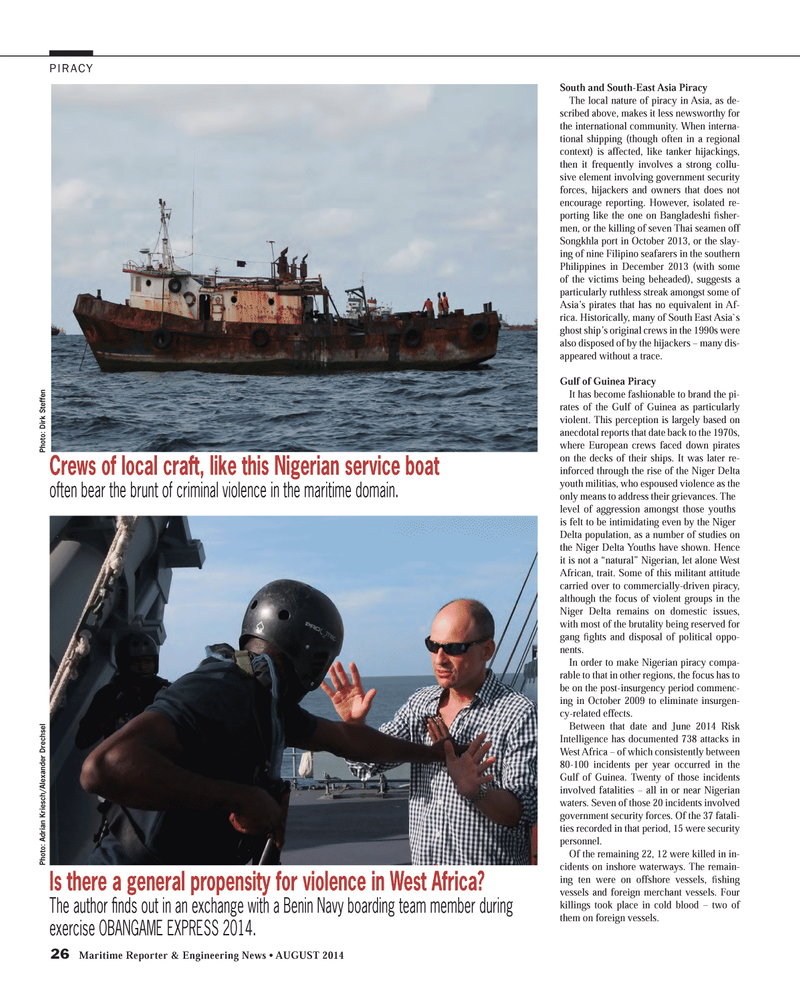
Page 26: of Maritime Reporter Magazine (August 2014)
Shipyard Edition
Read this page in Pdf, Flash or Html5 edition of August 2014 Maritime Reporter Magazine
26 Maritime Reporter & Engineering News ? AUGUST 2014 PIRACY Crews of local craft, like this Nigerian service boat often bear the brunt of criminal violence in the maritime domain.Photo: Dirk Steffen Is there a general propensity for violence in West Africa? The author Þ nds out in an exchange with a Benin Navy boarding team member during exercise OBANGAME EXPRESS 2014. Photo: Adrian Kriesch/Alexander Drechsel South and South-East Asia Piracy The local nature of piracy in Asia, as de- scribed above, makes it less newsworthy for the international community. When interna- tional shipping (though often in a regional context) is affected, like tanker hijackings, then it frequently involves a strong collu-sive element involving government security forces, hijackers and owners that does not encourage reporting. However, isolated re- porting like the one on Bangladeshi Þ sher- men, or the killing of seven Thai seamen off Songkhla port in October 2013, or the slay-ing of nine Filipino seafarers in the southern Philippines in December 2013 (with some of the victims being beheaded), suggests a particularly ruthless streak amongst some of Asia?s pirates that has no equivalent in Af- rica. Historically, many of South East Asia`s ghost ship?s original crews in the 1990s were also disposed of by the hijackers ? many dis-appeared without a trace.Gulf of Guinea PiracyIt has become fashionable to brand the pi-rates of the Gulf of Guinea as particularly violent. This perception is largely based on anecdotal reports that date back to the 1970s, where European crews faced down pirates on the decks of their ships. It was later re-inforced through the rise of the Niger Delta youth militias, who espoused violence as the only means to address their grievances. The level of aggression amongst those youths is felt to be intimidating even by the Niger Delta population, as a number of studies on the Niger Delta Youths have shown. Hence it is not a ?natural? Nigerian, let alone West African, trait. Some of this militant attitude carried over to commercially-driven piracy, although the focus of violent groups in the Niger Delta remains on domestic issues, with most of the brutality being reserved for gang Þ ghts and disposal of political oppo- nents. In order to make Nigerian piracy compa-rable to that in other regions, the focus has to be on the post-insurgency period commenc- ing in October 2009 to eliminate insurgen- cy-related effects. Between that date and June 2014 Risk Intelligence has documented 738 attacks in West Africa ? of which consistently between 80-100 incidents per year occurred in the Gulf of Guinea. Twenty of those incidents involved fatalities ? all in or near Nigerian waters. Seven of those 20 incidents involved government security forces. Of the 37 fatali-ties recorded in that period, 15 were security personnel. Of the remaining 22, 12 were killed in in-cidents on inshore waterways. The remain- ing ten were on offshore vessels, Þ shing vessels and foreign merchant vessels. Four killings took place in cold blood ? two of them on foreign vessels.MR #8 (26-33).indd 26MR #8 (26-33).indd 268/1/2014 2:33:12 PM8/1/2014 2:33:12 PM

 25
25

 27
27
